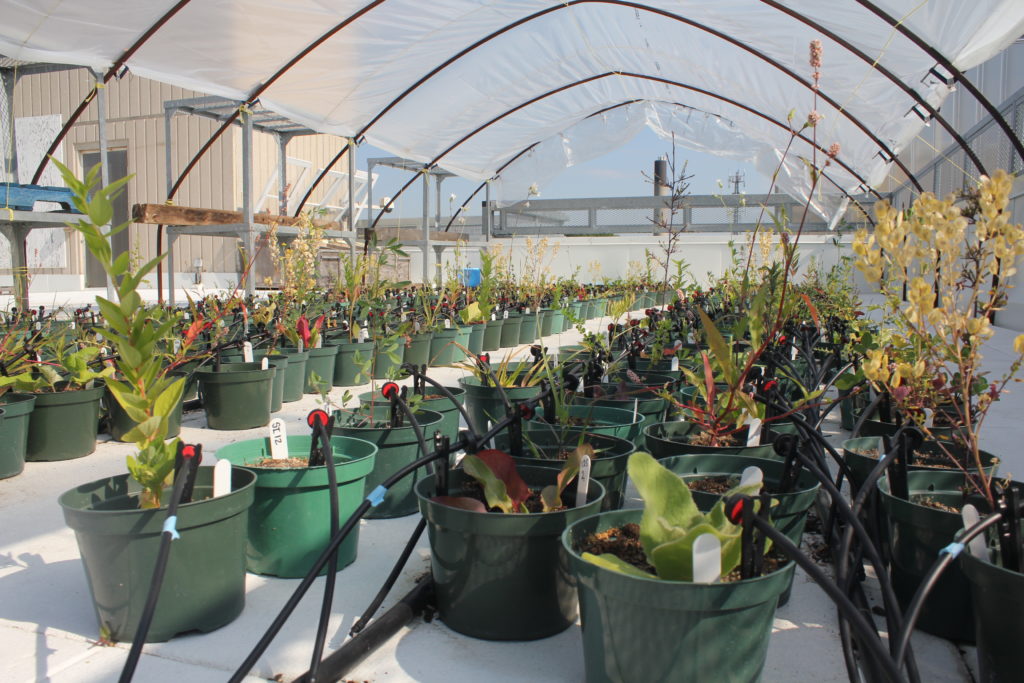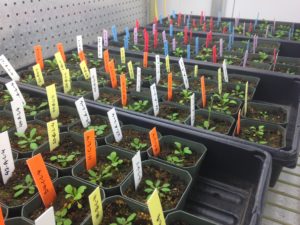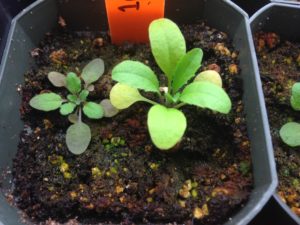The ecological importance of the plant root microbiome
“… almost everything about larger organisms has been shaped by their history of evolving from, then with, microorganisms.”
Moran and Sloan 2015
Diverse assemblages of microorganisms (aka microbiomes) are found everywhere we look. In the environment these microbial communities are critical for the turnover of energy and nutrients, processes which scale to influence the maintenance of global biogeochemical cycling. In animal hosts the gut microbiome plays an important role in nutrient acquisition, development, and immunity. Our understanding of the importance of the plant root microbiome is less developed. This project aims to characterize variation in the root microbiome across a wide breadth of host species. We’re also trying to understand the role of the root microbiome in plant response to
drought and plant-soil feedbacks (see below). Drought response and plant-soil feedbacks are important and widespread aspects of pant ecology in natural and managed systems.

Publications:
Fitzpatrick, C. R., J. Copeland, P. W. Wang, D. S. Guttman, P. M. Kotanen and M. T. J. Johnson. 2018. Assembly and ecological function of the angiosperm root microbiome. Proceedings of the National Academy of Sciences U. S. A. DOI: https://doi.org/10.1073/pnas.1717617115
The soil microbiome and the evolution of plant competition
How microorganisms affect the ecology and evolution of their larger plant and animal hosts is an exciting and important question. Our understanding of how animal health is influenced by their gut microbial communities has grown rapidly yet how soil and root microbiota influence plant health is still unclear. In order for host-associated microbes to affect host evolution three conditions need to be met: 1) the microbes associated with hosts must vary across individuals; 2) this variation must be heritable; and 3) there must be fitness differences associated with this variation across individual hosts.
We performed a large experiment testing the role of soil microorganisms in the evolution of plant competitive ability. We used natural accessions of the model plant Arabidopsis thaliana to explore whether these conditions are met and evolution could proceed as a result of plant-associated soil microbes.


Phylogenetic relatedness, phenotypic similarity and plant-soil feedbacks
What determines how strongly species will interact with one another? Let’s say we’re talking about two species that occupy the same trophic level (i.e. they aren’t eating each other), if they share the same habitat and require the same resources then their interaction strength might be high. Identifying the species attributes that dictate ecological similarity is surprisingly difficult and as a proxy biologists have begun using the evolutionary relatedness between species to predict their interaction strength.
In this project we investigated how evolutionary relatedness and phenotypic similarity across 450 unique pairs of plant species predicts the outcome of their plant-soil feedback (PSF). PSFs occur when plants influence the abiotic/ biotic soil environment, which then influences the growth of another plant. PSFs are important for numerous fundamental processes in terrestrial ecology (e.g. maintenance of plant diversity and productivity) and we’ve known about PSFs for centuries – traditional agricultural practices like crop rotation are based on the PSF concept. Due to the unique evolutionary history of individual traits and the variability in their importance across interacting species, we show that indices of overall phenotypic and phylogenetic relatedness are poor predictors of plant-soil feedbacks at large phylogenetic scales.
Publications:
Fitzpatrick, C. R., L. Gehant, P. M. Kotanen, and M. T. J. Johnson. 2016. Phylogenetic relatedness, phenotypic similarity, and plant-soil feedbacks. Journal of Ecology 105: 786-800

Genetic variation and contemporary evolution within plant species alters soil ecosystems
Individuals within a species can vary in ecologically important traits. For example, individuals can differ in their resource acquisition strategies, behaviour, morphology, and internal physiology. These individual differences can add up to affect population, community, and ecosystem-level processes. We think understanding these extended effects might be particularly important in scenarios where genetic variation is altered.
Individuals are usually arranged non-randomly across their range. Due to environmental gradients occurring at broad spatial scales, southern populations will exhibit phenotypic differences from northern populations. With global climate change species’ ranges are changing and populations are moving, sometimes rapidly, causing a large-scale reshuffling of genetic variation. Whether this introduction of novel genotypes will have consequences for associated communities and ecosystems is unknown. We’re testing whether the extended effects of genetic variation across the entire range of a focal plant species exhibit any geographical pattern. Specifically we’re looking at the effects of genetic variation in the plant species, Oenothera biennis, on the belowground invertebrate communities.

Publications:
Fitzpatrick, C. R., A. Mikhailitchenko, D. Anstett, and M. T. J. Johnson. 2017. Range wide effect of plant genetic variation on soil invertebrate communities. Ecography. DOI: 10.1111/ecog.03347
Evolution is another scenario where understanding the extended effects of genetic variation might be particularly important. When populations evolve accompanying shifts occur in the genetic variation present within the population. We wanted to know whether rapid evolution (<10 generations) could be driving ecosystem-level changes. We used replicate populations of the focal plant, Oenothera biennis, and manipulated the presence of insect herbivores on half the populations . After 5 generations of natural selection caused by insect herbivores evolution occurring within these populations actually influenced the rate of litter decomposition and nitrogen cycling. Additionally, we found that the ecosystem effects of evolution influenced the growth of plants in future generations. We were pretty excited by these results because they provide evidence for feedback loops between ecology and evolution, which to date has been very difficult to find.
Publications:
Fitzpatrick, C. R., A. A. Agrawal, N. Basiliko, A. P. Hastings, M. E. Isaac, M. Preston, and M. T. J. Johnson. 2015. The importance of plant genotype and contemporary evolution for terrestrial ecosystem processes. Ecology 10: 2632-2642.


